Got my machine today (For Her version for the lighter apneas/hypopneas) and the AirFit P10 mask with ClimateLine hose. Tried on the mask for a few minutes at various times. It feels reasonably comfortable. Not sure what the default size pillows are that come on it (medium?). Do they have some type of identifiable marking on each set of nasal pillows?
Masks questions: How tight should the bands be around my head and how far inside of the nose should these pillows fit? Should they rest just inside and enough to seal so that no air flows around the pillows and out of the nostrils? Or should they stick further in? The design looks like they should rest almost on the outside of the nose and just barely inside of the nostrils. This seems right, just not sure how far they should go in. I can already see that this thing is going to mess my hair up on a nightly basis with the strap going over the top of the head and behind the back.
Machine questions: There's a warning that says to not transport it unless the humidifier is empty. Obviously, water could dump everywhere. Is that because a bump/jolt could knock the humidifier tank of from the machine and get water all in the machine/case or will the water actually dump out of the tank somehow even while attached to the machine properly? For instance, if you had the humidifier full and just picked up the machine and moved it around or it got turned upside somehow...would water enter the machine without the humidified being detached? Should the machine be velcro'ed down to the table near the bed? If I'm sleeping and turn over onto the hose and it yanks the machine off the table, that's a problem. I have a little plastic rolling car next to the bed that I keep my alarm clock and such on. Should I upgrade that to a heavier wooden table and put velco on the bottom of the machine and top of the table to keep the machine from moving when the hose gets tension on it? I'm pondering if I should wait until tomorrow to try the machine all night until I can get a table that is more stable and some heavy duty velcro to keep the machine from being pulled off. Does anyone else use this method?
The hose is bound to get in my way while sleeping. I've had someone on here recommend using a hook/velcro to hook the hose to my shirt/pajamas while sleeping and keep it out of the way. What's the best way to do so?
I'm an AHI 5.2 in general based on the home study. In-lab study before that showed an 18 RDI. I have a mix of obstructive apneas/hypopneas. Over 5.8 hours, I had 23 obstructive apneas. The longest was 85 seconds and the mean is 34 seconds. The longest obstructive hypopnea was 29 seconds and the mean 23 seconds. So far, no central apneas suspected. I'm a 5.4 AHI supine, a 4.9 on my left side and a 3.1 on my right (seems a bit odd). I apparently don't drop down to below 91% even with the 85 seconds of apnea, which seems bizarre to me. I have gasped awake before feeling tingly from head to toe. I presume that was one of those longer events.
What's my best bet for settings? I'm trying to understand how the exhale works, as well. Does it blow the air continously or for x seconds and then step down in pressure for me to exhale before going back up in pressure for the exhale? How does it know when I'm trying to exhale or inhale? Or does it?
SD card: One was included and already in the machine, but how many nights does it store per GB? I haven't plugged it into the computer to get the GB size of the card yet.
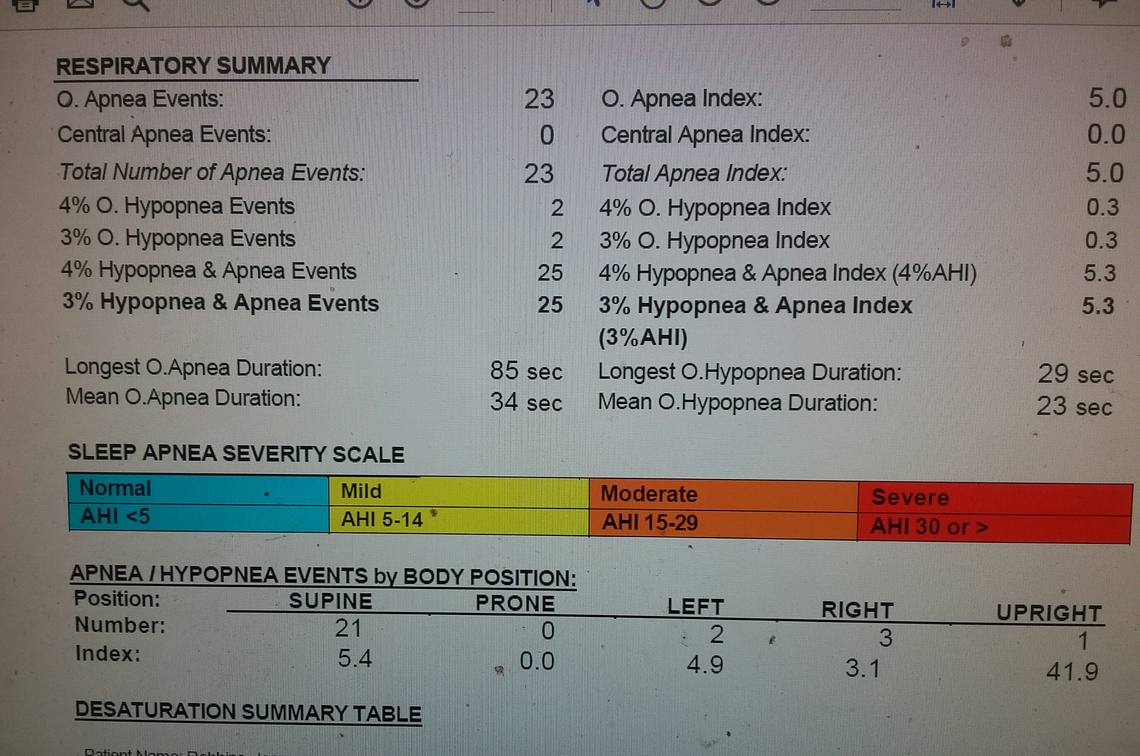
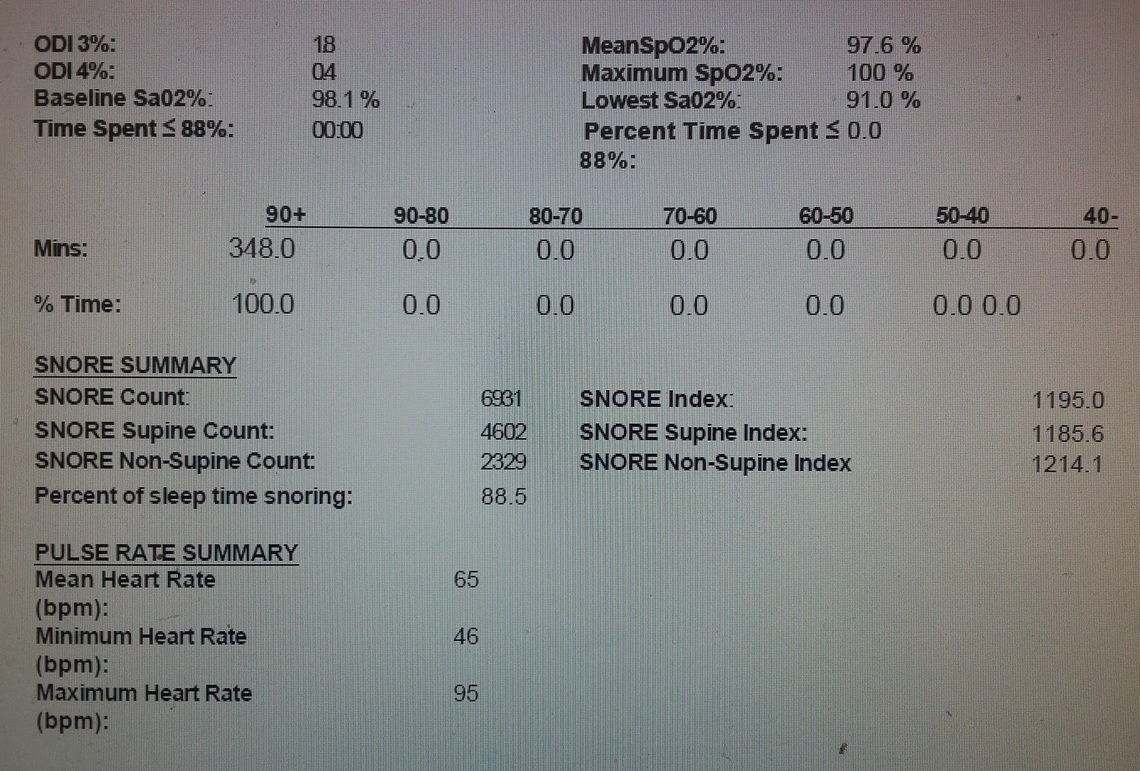
Mask
When a mask has not been fitted for you by a technician, the normal way to buy the P10 is with a fit pack which includes a small, medium, and large cushion sizes. You just try them and use the one that fits the best. You want it to fit on your nostrils not right into them. It will seal better if you use the size that goes right in, but I found that can irritate your nose. I use the Large size. When you look at the mask and are going to put it on, you have it oriented correctly when you can see the L and R for left and right nostrils. In the middle will be the marking for the mask size; S, M, L. The P10 is pretty much non adjustable although there are some goofy clips that can be used to adjust to some degree. I would just use it as is for a start. SleepyHead will give you a good indication of how well the mask is sealing. You should not feel any air leaking out where the mask seals to your nostrils. However there is a mesh screen on both sides of the front. Air will flow out of there continuously as a purge flow and also more when you exhale.
Machine
Believe them when they say not to move the machine with water in it. While nothing real serious will happen, you most likely will dump water into the hose and that will cause a bit of excitement when it blows into your nose. My machine generally stays put, and I have never pulled it off the bed side table. Ideally you want the machine about even with your head or even a bit higher. If you pull on the hose most often what will happen is the mask hose will separate from the machine hose. I did it last night. In a pinch you can put your machine on the floor if you have enough hose. A chair would do fine too if the seat is level. Everyone seems to do the hose differently. I have a headboard on our bed that I can loop the heated hose through to the middle of the bed and then down the center of the bed. The other option is to run it behind the pillow to the center of the bed. It comes down to about my waist. From there the mask hose goes up to my nose. When I sleep on my right side facing the middle the hose just lays in the middle in a loop. When I sleep on my back it just comes up over my chest. And, when I roll over to face the outside of the bed on my left side it loops over my tummy and comes up the left side on the bed and to my nose.
Settings
Settings are best suggested by your sleep clinic, but I know you are on your own, so I will make some conservative recommendations to start with. To answer your questions, yes the machine knows when you are exhaling. When it is in EPR mode it reduces the pressure when you have inhaled fully and start to exhale. It increases the pressure again when you have fully exhaled and start to inhale. It is in effect blowing continuously as those purge vents on the front will always have air coming out to prevent CO2 from building up in the mask housing. So here are the setting in the order they appear on the machine. You probably know it, but you press and hold the front Home key at the same time as the top round set knob for about 5 seconds to get into the Clinical menu. When there you rotate the knob on top to scroll down, and press it to make selections. These are the starting settings I would suggest for the maximum comfort using conservative pressures.
Make sure you set the Date and Time correctly or you will have trouble changing it later. If you press the Home key and then select return to User Menu, you will be out and the machine will be functional.
SD Card
The standard card is 4 GB and will probably hold most of a year's data before it starts to overwrite. If you regularly download to SleepyHead you will have a permanent record of readings on your PC.
Hope that helps. If you post your SleepyHead chart I can make some suggestions as to how you could optimize the settings further. If you have any other questions, just ask...
I went through the Clinical mode and changed all of the settings.
After a little while of playing with the controls and wearing the mask (not while sleeping), I adjusted the max pressure down from 12 to 10 because 12 felt overwhelming during the times when it just blasted on at full pressure. It may be that I'll end up adjusting down even more if 10 still feels too strong.
I guess I need more time to get used to the controls. It seems like it blows a very light amount of air even after I tell it to "stop" or hit the power button. In fact, hitting the power button makes it blast out air full speed. It knows when I put the mask on (because of the setting), but it also starts blasting air wildly at max speed if I don't put the mask on fast enough. When I hit the start button, I see it display 4 minimum on the screen (and I could take it up to 5 or whatever other setting is comfortable)...but when I purposefully stop breathing completely, it shows on the screen that the pressure is set on auto from 4-10...yet it never shows that it kicks up above 4 even while I cease breathing and just sit there watching to see what it will do and seeing if it will ramp above 4. Nothing shows up on the screen, but is it simply ramping and just doesn't visibly show what number it has auto adjusted up to in the middle of the event or what?
When I'm up for the day, should I be using "stop" or hitting the power button when taking the mask off to stop using it? Or both?
The times when it turned on to test the mask or before putting the mask on, it blasted air out at seemingly max speed and that seemed ridiculously high. The mask is getting good seal readings on medium pillows per the built-in mask test.
I found myself wanting to adjust the start pressure down from 7cm because my lungs felt weird (and oddly enough, my chest kind of "hurt" a little tonight after breathing with it while still awake and upright) and also it just felt "too strong" for some reason. I turned it down to the minimum of 4 just to see. I have read that some people feel suffocated, and I agree...that does feel suffocating. I played around between 4 and 5 for the minimum pressure. However, I still feel like the exhale is too hard to do for some reason. I have the EPR set to Ramp Only and to 3. What else am I doing wrong? Sometimes the exhale feels hard to do and other times it seems just fine.
Also, I hear a good bit of rushing air through the tube. Is that normal? Of course, the feeling of having air blowing into my throat also feels quite strange, if even a little sickening feeling sometimes. Regardless of my settings, it seems like when I hit start, it blasts air out at max speed and then seems to slowly kick down to the minimum. Is that a common thing that I just have to get used to or another setting?
It seems to blow a light amount of air even when the machine appears to be "off" or when I have hit the stop/power button...but when I hit start or put the mask on, it seems to blow at max speed even though I have the settings set. Should I set a progressive ramp time or something?
My breathing reminds me of Darth Vader. Do I have something set wrong or is that how it sounds? I'm getting the regular air purging out of the front of the mask plus the air when I'm exhaling. I guess I thought it would be a little quieter?
Based on your comments I am not totally sure you have the machine set up correctly. When you enable the SmartStart option it should just start with a smooth even pressure buildup when you put the mask on. It may take a breath or two, but it should just start. Then you will see the pressure ramp up to your minimum slowly. Keep in mind that the minimum pressure setting is independent from the ramp start pressure. If you want to lower them below the 7 cm I suggested you have to adjust them both down. The ramp start cannot be lower than the minimum pressure. When you start the machine it should go to either the ramp start pressure if it is lower than the minimum, or if they are the same then to that pressure.
The machine tries to maintain a set pressure, so if you turn the machine on without you having the mask on, then there will be a big rush of air as it is trying to build up pressure with no resistance to flow. I just use the SmartStart option and I just have to put the mask on to start the machine for the night. When I take it off, I usually push the machine off button just before I take the mask off. It stops that big rush of air. However if you just take the mask off there will be a big rush of air and then the machine will stop from the SmartStart control. The machine is set to maintain a small air flow after you shut it off to let it cool down and purge moisture. You should see a little icon on the screen indicating it is cooling down.
As far as maximum pressure of 12 or 10, that setting should not have a big impact on the pressure you are getting as it will only go up to that pressure if it detects apnea or hypopnea. It is simply a maximum, and I would expect in your case it will not go that high. If you wake up in the night and press the round button it should display your current pressure that it is controlling to in automatic. However, SleepyHead is the best way to see what goes on during the night.
I believe when you do the mask fit test it goes to the maximum set pressure for the test. However, in auto it will not go there unless it has to.
With the EPR set to ramp only and set at 3 cm. It will always be trying to reduce the exhale pressure by 3 cm. However the machine will not go below 4 cm no matter how you set it. So if you have a ramp start of 5 cm, it will reduce to 4, and with a ramp start of 6 it reduces to 4 and so on. Only if you have a ramp start higher will the exhale pressure be above 4 cm. For example I use a ramp start of 9 cm because that is what feels right to me. During the ramp I get 9 cm on inhale and 6 cm on exhale. As far as it feeling hard to exhale that is something you get used to. After my ramp is over the machine goes to 11 cm on inhale and exhale. I have no difficulty exhaling against that pressure or even higher. Some people exhale against as much as 25 cm on a bipap machine. '
Hope that helps some. One other feature I may not have mentioned that can improve comfort some is the prewarming of the humidifier. You can turn it on manually with the menu item that I recall is just below the mask fit option. It warms up automatically and there will be a small air flow during the warming. It takes about 15 minutes to fully warm up, and then it sits on hold. I usually turn it on when I first start getting prepared for bed, and then use the machine regardless of whether or not it is fully warmed up or not. The machine will still start as soon as you put the mask on and take a couple of breaths.
Any other questions, or if I missed something just ask. You will find SleepyHead very enlightening as to how the machine is performing. All of those pressure changes when going through the ramp can be seen in SleepyHead. If you zoom in using the arrow keys you can see each breath and how much the pressure is going up and down during the ramp. It is a good way to confirm that the machine is performing as you expect it to. An most important it will show what the machine does with pressure after you go to sleep, and whether or not you are having any events. Here is what my machine mask pressure looks like during ramp. This is with a ramp start of 9 cm, EPR of 3, and then a pressure of 11 cm when the ramp ends.

I wore it for 3.7 hours when I went to bed last night. I took it off after that. I felt tired and irritated, for some reason in my sleepiness thinking that I couldn't turn over on my side (which I can and just dangle the mask and hose off the edge of the pillow). AHI showed 0.8 for that 3.7 hours when I checked it this morning. It said something like 10L of leak.
I changed my starting pressure from 4 to 5 before bed. Then moved to 6 starting pressure because I felt like I was suffocating and trying too hard to breathe in and out. So starting was 6 and I think minimum was 6 and max was 9.
I wake up sometimes with it feeling like it is making my soft palate in my throat flip and gag me or something. I sort of choke awake from the air being too strong or something. I don't know of those are actual hypopneas/apneas that it is correcting or what. My lung felt a little funny and sore this morning.
I don't understand why it doesn't ramp when I stop breathing on purpose to test it, for instance. 6 starting, minimum set at 6 and max at 9. If I'm up and awake and wearing it...breathing normally and then I stop, I expect it to ramp to up to 9 to clear what it should think is an obstruction. Does it wait x minutes before the ramp takes effect when set to Auto?
"I don't understand why it doesn't ramp when I stop breathing on purpose to test it, for instance. 6 starting, minimum set at 6 and max at 9. If I'm up and awake and wearing it...breathing normally and then I stop, I expect it to ramp to up to 9 to clear what it should think is an obstruction. Does it wait x minutes before the ramp takes effect when set to Auto?"
The machine suppresses reporting of apnea events and response to apnea events when it is in ramp mode. This is because they are unlikely to be real when you are not sleeping. The ramp period automatically ends when it detects you are sleeping, or after 30 minutes, whichever comes first. So, you would have to wear it at least 30 minutes before trying to trick it into increasing pressure.
The AHI of 0.8 and leak rate of 10 both sound good. I think most of the issues you are having are normal for someone just starting on CPAP, and you will likely adjust to it quite quickly. I did not adapt all that well to wearing a mask, especially a full face mask, but I have always used the machine for the full night since the first day I got it. The worst experience was when trying a full face mask, and I gave up in the middle of the night and switched back to the P10 for the rest of the night.
Hope that helps some,
Alright, so I went through and took photos of what I saw on the machine:
Sleep report Usage hours 3:40 Evens per hour 0.8 Mask Seal :) Humidifier :) Pressure 9.7 Leak 14L/min AHI 0.8 Total AI 0.5 Central AI 0.2
Settings (Clinical) Mode Autoset For Her Max Pressure 10.0 Min Pressure 6.0 Mask Pillows Ramp Time Auto Start Pressure 5.6 EPR On EPR Type Ramp Only EPR Level 3 Climate Ctrl Auto Tube Temp 81F AB Filter No Essentials Plus SmartStart On
Earlier tonight, just for a few minutes while up and awake, I put the mask on to see what the pressure was like that I was using last night.
As I mentioned before, the 4.0 Start Pressure made me feel like I was struggling to breathe and get enough air in general. It made it feel like a lot of work. Last night was my first night with the APAP, so I had a lot of stuff going on, too much to do, went to bed late, had caffeine before bed and all sorts of stuff going on that certainly wasn't helping my cause for sleep. I didn't have a lot of time to understand the settings and such, just set it and put them on and played with it here and there before going to bed in order to get it to a tolerable level.
I stopped at 5.6 when I was playing with the settings because 6 Starting Pressure felt too high and a bit uncomfortable. 5 Start Pressure felt too low and not enough air flow/too much effort to breathe. Minimum Pressure of 6 (which it obviously kicked up to 30 minutes later or whenever I went to sleep - how exactly does it know when I'm sleeping vs awake?) and Max Pressure of 10. Now in my sleep report above, it shows a pressure of 9.7. I had the max set at 10, so was 9.7 the magic number that it stopped at to clear my apnea/hypopnea? 0.3 difference from 10 obviously isn't that much, but it didn't go all the way, so it must have cleared. Should I just leave that max at 10 or try a little lower?
So now that I have more time, I understand the general idea that there is the Starting Pressure (what it raises up to when you first turn it on), then the Minimum Pressure that it goes up to once you're asleep and the Max Pressure that it can go up to per the setting that you give it.
I'm wondering sometimes if my little choking events aren't happening by opening my mouth and the air basically trying to blow from the back of my throat and out of my mouth, probably pushing the soft palate forward. It doesn't seem to happen that much, but I have noticed that it does something similar when I open my mouth while upright and testing the pressure.
I think it is set up properly now...I just didn't understand the mask test part at first where it seems to blow extremely hard when testing. When I put the mask on, it ramps up from 0 to my Starting Pressure within a few breaths. The first two breaths are difficult I presume because it is isn't blowing pressure yet.
I'm just trying to figure out mainly what to have the Starting Pressure and figure out what is not enough vs too much. The 5.6, when I try it upright, feels like it is a bit too strong. Yet when it was down on 5 last night when I was about to go to bed, it didn't feel like enough.
How do people know what to set their minimum and max ramp to? I know that the machine won't ramp up beyond the max setting and may not even reach the max setting if the obstruction is cleared beforehand and it kicks back down. I'm just trying to figure out if it could have cleared the obstruction with say...7 or 8 instead of 9 or 10 given that it went up to 9.7. That could very well have been the cause of my gagging feeling here and there throughout the night, as well.
When I remove the tank and empty it every night to put fresh distilled water in...should I just wipe down the little bit of moisture in there with a paper tower or something? I see condensation in the upper part of the tank that I can't really get to in order to wipe it out. Should it be washed out with tap water?
Your readings and settings look pretty good. This is the definition of the pressure you see on the Sleep Report:
Pressure - Average pressure during the selected period (95th percentile for each day; average of the 95th percentile values for periods >1 day).
In other words for the night 95% of the time the treatment pressure was less than that number. In your case 9.7 cm. So, it may have reached the maximum pressure of 10 that you set. All this is far easier to see on SleepyHead, as you will see the actual pressure throughout the whole night. It gives you a much better idea of what the machine is trying to do. Just a comment, but I am surprised that it is reaching 10 cm. I would have expected your pressure to stay lower than that. On the plus side, the fact it is going that high suggests the APAP is of value to you.
On the ramp start pressure what I do is breathe in quite deeply and quickly. What I am looking for is a pressure where the in-flow feels free and unrestricted like I am not wearing a mask at all. Most people breathe more heavily and deeply when they first go to bed. Under those circumstances you do not want to feel like you are suffocating. If 5.6 works for you, that is fine. You may find as you get more used to the machine you will like more.
ResMed does not disclose how they determine when you are asleep. However I suspect they base it on a very uniform breathing pattern that is not deep and irregular like it is when you first go to bed.
Pressure settings - For now I would leave Maximum at 10. Your AHI is very good. The 95% pressure of 9.7 kind of suggests the maximum should be higher, not lower. But your good AHI suggests it is high enough. You only have a few hours of data, so too early to make a change. As far as the minimum pressure goes, it potentially could be higher, but since you are just starting out and your AHI is good, I would leave it where it is. If your AHI was high it can often be reduced by increasing the minimum pressure. What it does is get pressure up sooner so events are avoided instead of responded to. In other words the machine gets out ahead of the potential problem.
When dumping your water and refilling it, I would just shake the reservoir up to dissolve any sediment, dump it, and refill with distilled. I have to admit that I don't dump the water every night, just about once a week. On the weekly clean I rinse it out with pure vinegar, then tap water with Dawn dish soap, and finally just a rinse with tap water. I do the same with the heated hose, and mask. Best to do it in the morning and then hang them up to dry during the day. I don't bother drying the reservoir though.
Opening your mouth and letting air escape can be a problem with a nasal mask. The usual sign of it is a dry mouth in the morning and a high leakage rate. Your leakage rate is pretty good, so I wouldn't immediately suspect it is a problem.
Good luck tonight!
I can't remember if I gave you this link before. It is to the ResMed AirSense 10 Clinical Guide. This gives you some written guidance on the settings. Pages 4-11 are a good read if you want to understand better what the machine is doing and how it works.
So generally I seem to keep the mask on for 3-4 hours before it either comes halfway off and I just instinctively pull it off while still mostly asleep or maybe I have a hypopnea/apnea and it kicks up the pressure and I pull it off sometime afterwards, not sure. Sometime tonight I'm going to look into the past 3 nights with Sleephead and see how many events there were and such for each night. I see general max ramps from between 8 and 9-something on average.
Lungs feel a little sore sometimes in the morning for some reason. I keep my start pressure and minimum pressure at 5.2 just in case it ramping up a little more is waking me up after I have fallen asleep. Max pressure is set to 10. The 5.2 seems to be the "sweet spot" for me where it isn't blowing so hard that my throat is trying to keep the air from blowing out of my mouth and yet the pressure is sufficient to not feel suffocated. Anything more than mid-5's and it starts feeling too strong for long-term.
Today I wore it some again last night (and pulled it off again) and then put it back on again this morning when I went back to bed, so a total of about 5 hours 17 minutes. Events per hour are 1.8, mask seal and humidifier show good, pressure showed as 9.1 this morning (it was low 8-something before I went back to bed for a second time this morning), 17L/min leak, AHI 0.9, total AI 0.5, Central AI 0.4.
I don't seem to have any issue with air blowing out of my mouth, but I'm learning little quirks like if I want to clear my throat with the mask on, I need do it during an exhale when the pressure is backing off. If I open my mouth on an exhale, it doesn't usually do anything, but if I do it on an inhale I'll get a little choking air feeling in my throat until I close my mouth.
So it looks like I have a slight amount of central showing up. Is that normal for pretty much anyone? I've been reading lately that sometimes CPAP (and I would imagine APAP, too) can "cause" Central Sleep Apnea by having pressure settings up too high or simply the Central Apnea has always been there, but pops its head up when the Obstructive Apnea is dealt with.
I am one who experiences pretty deep sleep sometimes. I wake up and feel like my whole body is slightly "moving/fluttering" even for a few minutes after I am up and walking around. It only seems to happen when I'm flat exhausted.
On the mask coming off, that is one of the issues with the flimsy headgear on the P10. One of the things I found helpful is using a satin pillow protector instead of the usual pillow case material. My theory is that my head and the headgear slips around better on the pillow without dislodging it. At some point I also cut and sewed the straps back up so they were shorter. And as you know my final solution (hopefully) is to convert it to use the Swift FX headgear. It is much more stable. One of the other somewhat goofy solutions I tried was wearing a Speedo lycra skull cap over top of the headgear. It actually worked quite well, but left a significant mark on my forehead by morning. I suspect it was too small, but I couldn't find a larger one...
As for typical AHI and types of events, I would say that there is quite a wide variation in what is normal. My wife was diagnosed with an AHI in the 80+ range. Her AHI now averages under 1, with about 0.1 of it being central. I was diagnosed with an AHI of 37, and now average about 2.7 with half of it being central events. Hypopnea is also high at about 1, which leave my obstructive index quite low at 0.4. So, I'm not sure there is a typical. Your numbers however are very good. I don't see any indication that the pressure is causing central events. However that is much better determined with SleepyHead. When you look at the daily report you can make a correlation between when you have central events, and what the pressure is at that time. If you consistently see the centrals at the higher pressures, then there might be a bit of an issue. It can be fairly easily controlled though, but lowering maximum pressure more, if that is the case.
Hope that helps some
I've been reading through the manual for the machine and it talks about how the machine may not ramp up pressure during a central apnea event, but instead keeps the pressure the same. I know that central is that your brain/brain stem "forgets" to tell you to breath for a certain amount of time, so I can see how the APAP or a CPAP wouldn't be able to treat it in that sense. I suppose it is good that I don't seem to have much, if any (possibly just my pressure causing the small number of centrals).
I'm kind of wondering how long it will take to feel better in general, however. I still feel exhausted every day, have a very physical job for half of the day (lots of lifting and walking) and I work 50 hours a week every other week and 45 hours a week every other week. I seem more "alert" and feel better rested in general, but somehow I still feel like I'm half dead and in a fog at other times.
Yes, one of the underappreciated good features of the ResMed and Dreamstation machines is that they have the ability to differentiate between obstructive and central events, and then take the appropriate action for a central, which is do nothing. Some machines like the Fisher & Paykel cannot differentiate and actually increase pressure in response to a central. For someone that is sensitive to pressure that causes centrals that is a bit of a disaster. You get a central, pressure increases, and you get more centrals. The basic principle of a CPAP is to increase pressure to open the airway. With a central the airway is not the problem.
A CPAP is not the cure all for everything. They certainly can reduce the number of obstructive apnea and hypopnea events. Now does that translate into better sleep, and feeling more rested, with more energy? Yes in most, but potentially not in everyone. I think the main thing for a new user to concentrate on at first is getting comfortable with the machine. The irritation effect of the machine can nullify some benefits. One needs to make friends with the machine to reduce that effect, and let the benefits take over. I now look forward to going to bed and having that warm moist pressurized air making it so easy to breath and get to sleep.
I find sometimes that the warm air makes me a little hot. I keep it at 80, but may end up turning it down a little when it hits August, our hottest month. I'm actually getting quite used to the mask itself, but just fighting the band. In the picture, they show the guy wearing one strap on top of the head and one behind the head. So when I saw that when buying it, I thought, "That should be pretty stable!" Nope, as their instructions mention, you can put each band that way and it will actually loosen the mask. Or put both bands behind the head and it will make it the tightest. I use both behind the head.
I attached the machine to the wooden table at the head of my bed, about half of a foot from the bed. The table is about the same height as the bed. The excess hose hangs down between the table and mattress. For the hose, I run it underneath my pillow and leave about 1.5 feet of extra room while I'm wearing the mask so that I have room to move around and change positions without the entire hose going everywhere.
The first day seemed so intimidating. "How am I going to learn all of these settings and what they mean??" kept going through my head that first night. I do like the autostart feature so that I don't have to keep hitting buttons and I can just put the mask on. I have gotten quite comfortable with wearing it apart from the light soreness of the lungs that I feel in the morning for some reason. I would probably feel great if I could just keep it on for the whole night and stop taking it off.
I may have a very light touch of central. I do find that even when I have the mask on at night, there are times when it feels like my body just doesn't want to breathe and I stop for maybe 10 seconds while I'm awake. It is something that I can control physically, but seems to also be because I feel so lazy/tired that I don't want to breathe for that time. It makes me wonder if I do that while sleeping. I actually do that sometimes when I'm upright. It may very well just be because I'm so exhausted from all of the lack of sleep.
So far my "best" day was probably today. I still didn't wear it enough, but it gave the best window of what is going on compared to the past few days. It was a split day where I slept some that night, got up and then slept some later that morning. But I had the settings more of where I wanted them and I see a number of hypopneas/apneas. For some of them, I see odd numbers next to each event when I hover over it at a particular time stamp.
For example: Clear Airway (13), Hypopnea (10), Obstructive (25), Clear Airway (17), Clear Airway (12), Hypopnea (10), Clear Airway (13), etc. What do these means? Is that the length of seconds of the event or something?
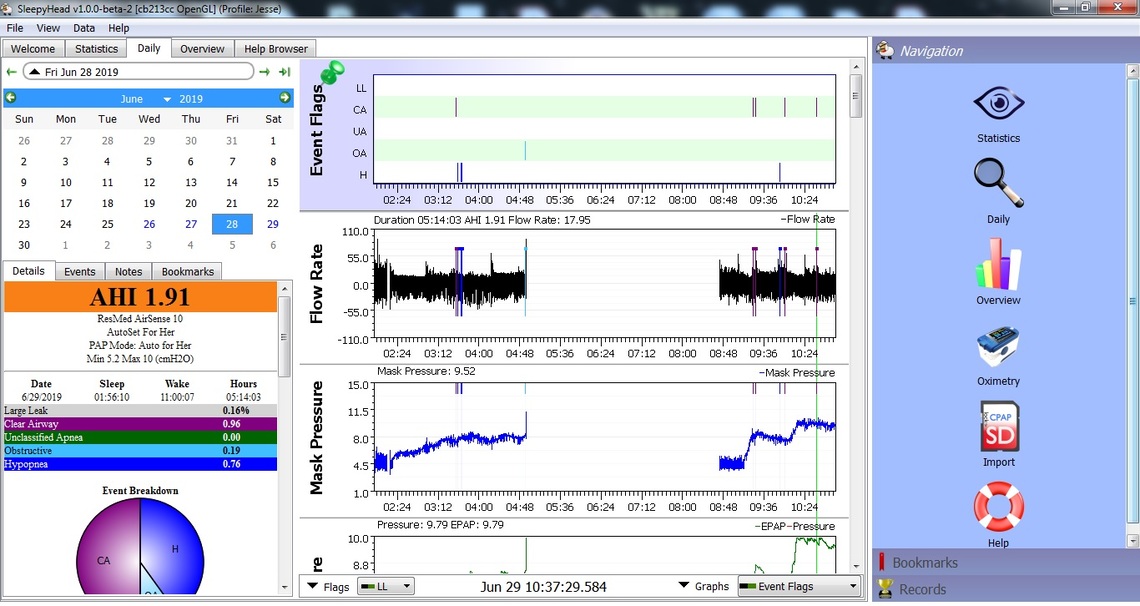
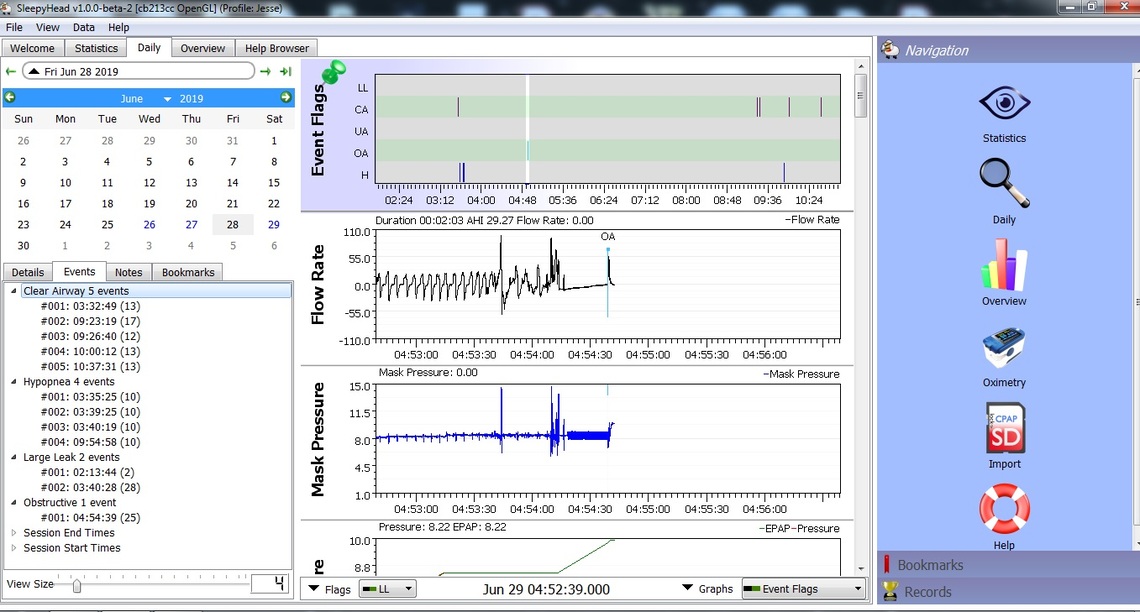
I'm not sure what the best view window is to get the most detail visible for a particular day.
As for the Centrals...nothing shows up to give me details about that. Could just be the way I had the mask on that confused the machine or something. I don't see any Centrals in sleepy.
One option you could consider is to not use the pre warming feature. I do it when I remember it, but don't sweat it when I forget. My feelings are that the most critical part of the sleep is getting to sleep. I consider it a good night when I can get to sleep in about 10 minutes.
This issue I have found with leaving the excess hose off the bed is that the weight of it pulls on the mask. However, if you anchor it under your pillow that should not be a problem.
On the central concern SleepyHead will be enlightening. You will see every one, and even the ones that do not last long enough to be flagged. For now, I would not sweat it. You seem to be adapting to using the machine very well. I think you were questioning whether or not you needed a machine. The pressures you are seeing suggest you do need one.
The number in brackets after the event is the length of it in seconds. It does not get flagged as an event until it is 10 seconds or longer.
There are a few things you can do to make better use of your screen though. The F10 will get rid of that kind of useless Navigation menu block on the right. If you click on the black triangle beside the date you can hide the full month calendar. The pie chart is kind of redundant and takes up a lot of space. If you go to File, Preferences, Appearance you can uncheck the box that says show the event pie chart. The bars above it give the data too, so nothing is lost.
As far as your data nothing jumps out. The only obstructive event was at 8 cm pressure, and it looks like it woke you up. It may have been that you were waking up already for some reason. Your central events seem to have occurred at a pressure of 8 or less except for one. It is not obvious why there was a pressure increase around 10:00 other than what appears to be a single hypopnea event. But not much to worry about for now. You need more data to come to any conclusions.
"As for the Centrals...nothing shows up to give me details about that. Could just be the way I had the mask on that confused the machine or something. I don't see any Centrals in sleepy."
RedMed/SleepyHead calls central apnea events "clear airway events", or CA. Essentially the same thing.
Alright, so I'm getting pretty decent at navigating Sleepyhead. I've been upping my machine settings lately. I think I'm going to start off with around 5.8 to 6 pressure now with the goal of basically not having to ramp up as much when I'm asleep.
Wore it just under 3 hours this morning before I yanked it off during the night and I remember laying there about to put it back on and I was so tired that I fell asleep with the mask off. I woke up at one point to see that my pressure had spiked up in the upper 8'scm. Not "high" necessarily compared to some people, but higher than I thought. It seems to have stayed that way for a lengthy period of time, too. It looks like it ramped and stayed high to keep the airway open, or maybe it was the tongue it was trying to keep from falling back. The little bit at the end was where I tested it after I woke up and adjusted it up to 12 max with a starting of 6.
I presume that my lungs will strengthen a little and get more used to the sore feeling of 6. I see it as...the higher the pressure already is at, the less it has to ramp later.
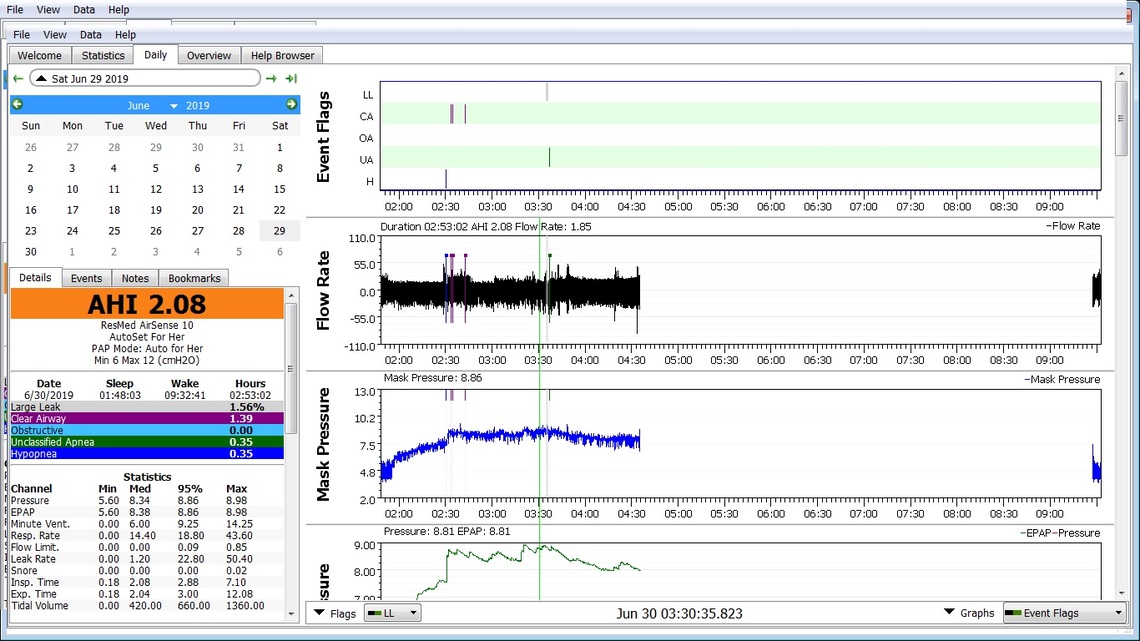
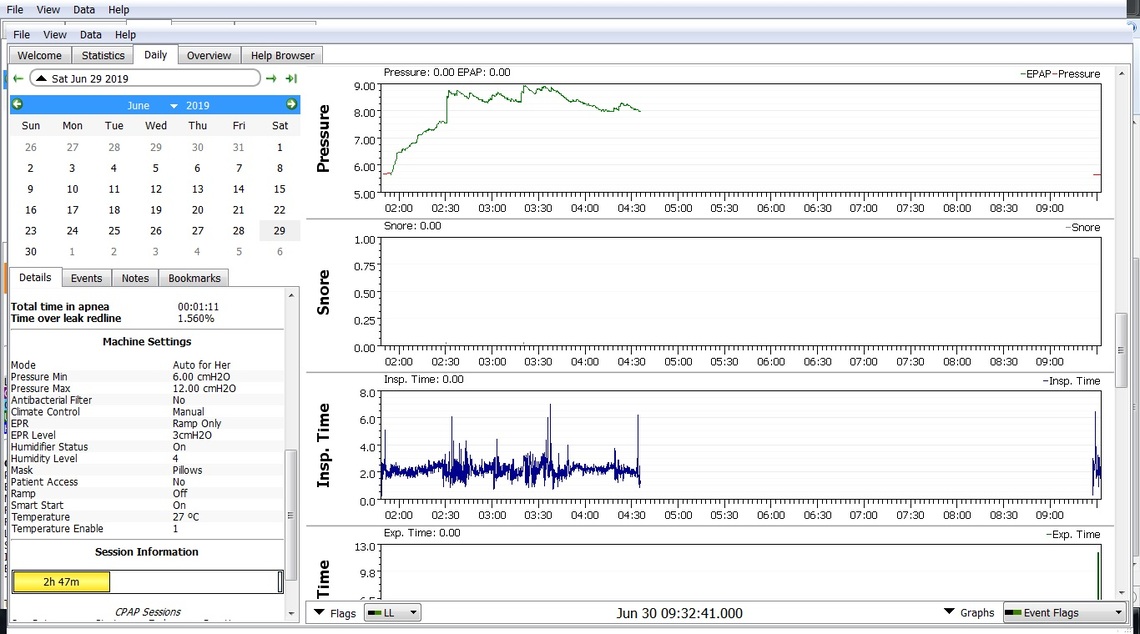
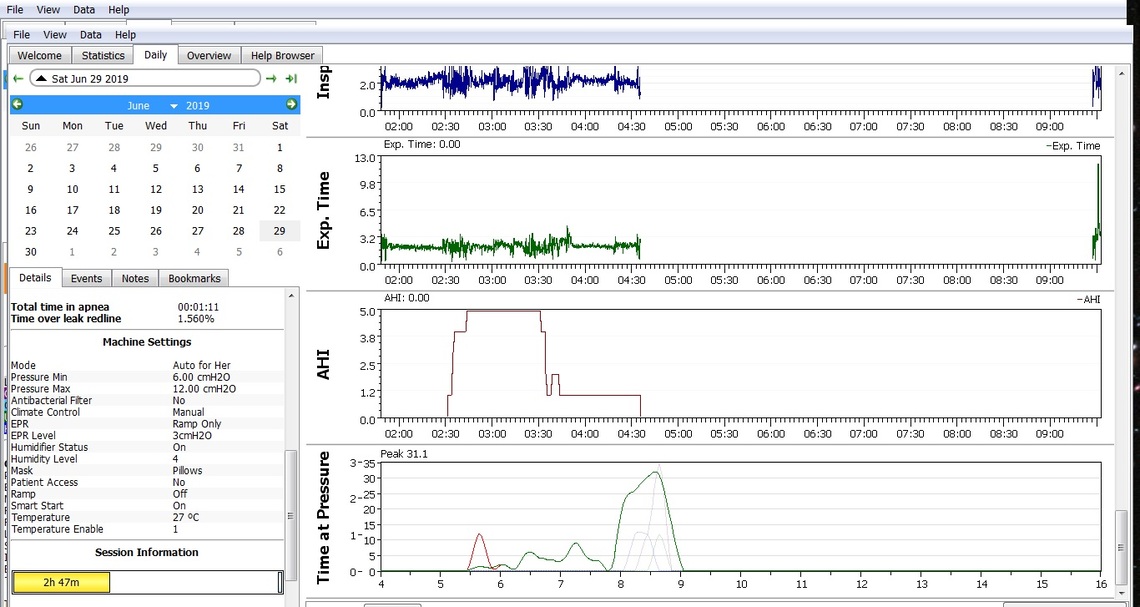
Also, there's an odd thing that I've noticed in Sleepyhead since the other day. The results from 6/30 will show up in Sleepyhead as 6/29 for some reason. The machine date/time settings are correct. In some parts of Sleepyhead, you can see the date and it is correct. In other parts, it isn't. Just a bug?
I believe in the setup section you can adjust the time the day starts, and by default it is usually 12 noon to 12 noon the next day, and all sessions within that time window get assigned to the day starting at 12 noon. So, you may be just looking at session times vs the nominal day. Again, if you click on that black triangle beside the current date it will suppress the whole month view and give you more room on the left to include most of the detail as well as the session data. You can also suppress a session you don't want to see or be included in the day statistics, like a mask fitting session, by clicking on the switch beside the session to turn it red for off.
Yes, in general it is a good idea to work up the minimum pressure as you become more used to the machine. About the only thing I see a little concerning on these charts is that it appears a hypopnea brought the pressure up and right after that you had a series of CA events. You will want to keep an eye on that. If this becomes a pattern, you may want to limit the maximum pressure the machine can go to. It could avoid some of those CA events.
Also after you get more data and a better idea of how the machine is behaving it may be worth a trial using the standard AutoSet mode instead of the For Her version, just to see which one is better for you. And also at some point it may be worth considering a fixed CPAP mode and a fixed pressure. You could do well with a fixed pressure of about 8 cm if it is high enough to avoid the OA and H events, but not too high to initiate CA events. But, too soon for that stuff. For now I would concentrate on getting used to the machine so you can get through the night with a good sleep.
My events spiked some last night. Over the past 2-3 days, I wake up in the middle of the morning at like 3am. I've been asleep for a few hours and I wake up to look at what pressure setting I'm at. It is usually on somewhere 8-ish to 9-ish. I've seen up to 9.75. Sometimes I'm seeing spikes for 30 minutes or more that it ramped up to say 7 or 8 and stayed. I thought it was supposed to ramp back down after the event is cleared...?
Trying to figure out what is going on with that. AHI can average up to 2 sometimes and I may see a 1+ Central Apnea. I don't see that many events this morning, but it seemed like it ramped up to 8 and 9 for a long time this morning. Should I adjust my settings down or something? There were many times when I was drifting off to sleep again and it was like I just relaxed and stopped breathing (didn't even try) and then the pressure kicked in on the machine for some reason and the air wanted to blow out of my mouth and kind of choked me in the throat. It felt more like a Central to me, but that's obviously not supposed to happen as it shouldn't ramp with a Central.
I seemed to get air leaks here and there from around the nasal pillows using the medium, so I'm trying to large ones tonight.
I don't understand why my ramps are up to 30+ minutes long if I'm reading that correctly. Will increasing my starting and minimum pressure to something like 7 help prevent some of that and lower that Central and OA number?
I think I'm going to try the regular mode and see how that does, as well. Is there a difference in the pressure settings between "For Her" mode and regular? Is a 6.0 For Her the same setting as 6.0 regular?
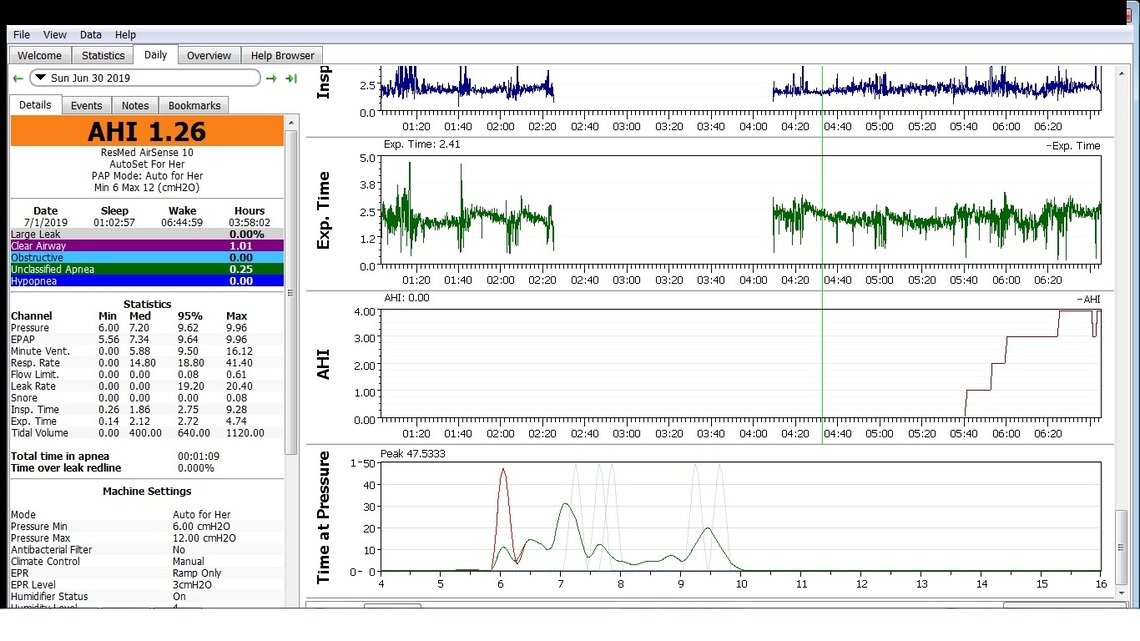
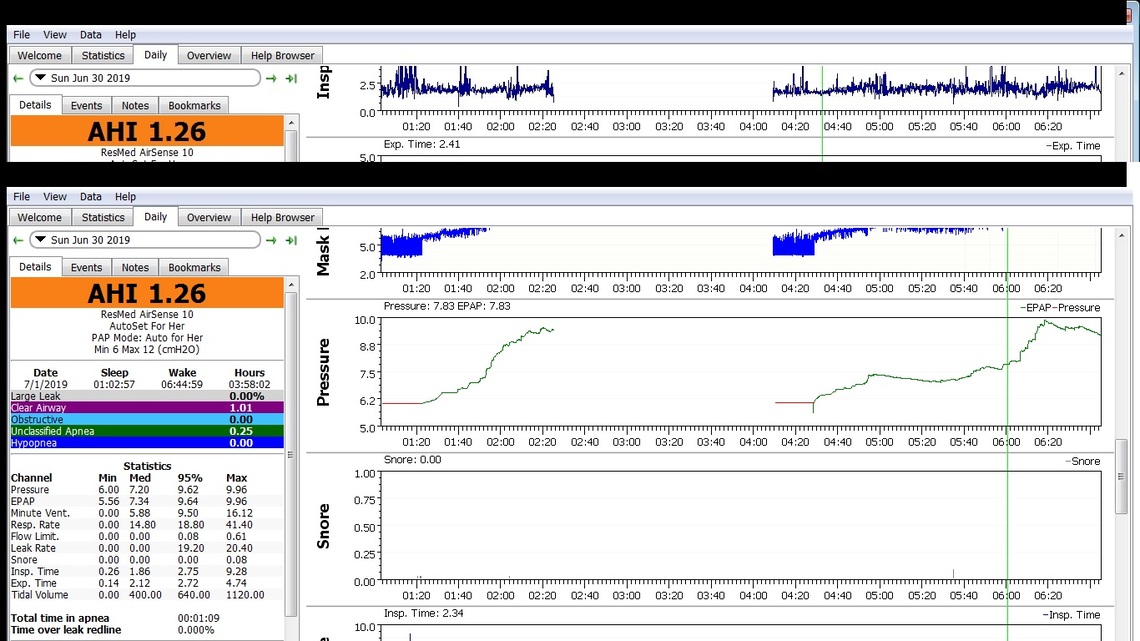
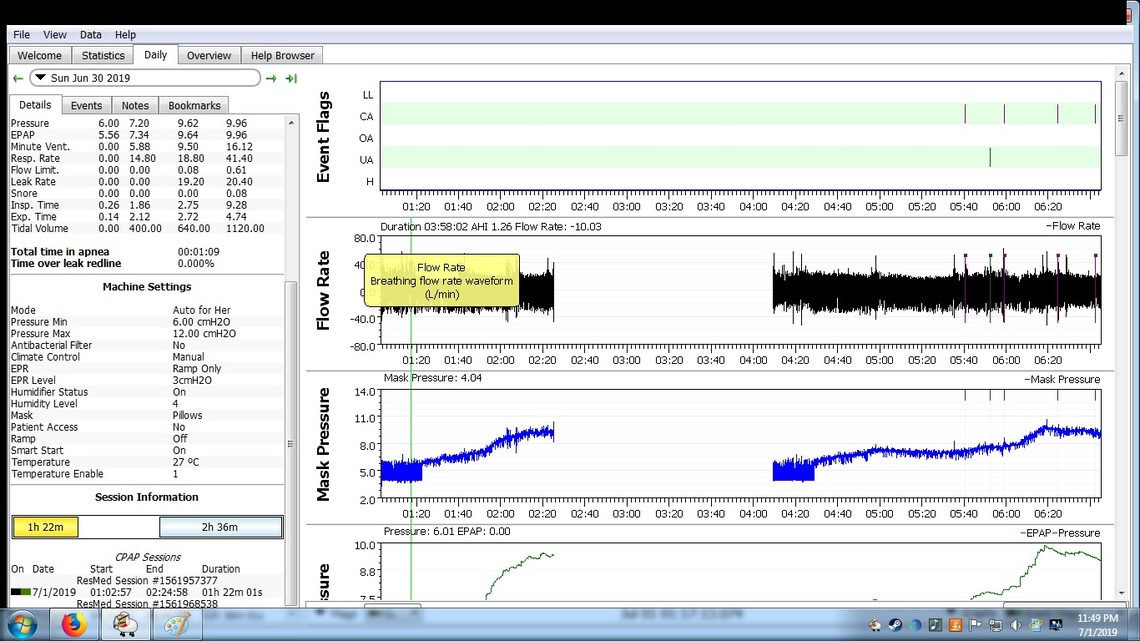
You can read the Clinical Manual but my recollection is that one of the "features" of the For Her mode is that if a certain number of event happen within specified time period, then the pressure does not come back down. There are some pros and cons to that. It can prevent more events, but it also can keep pressure up higher longer than necessary.
My thoughts based on the limited data so far is that it could be of benefit to lower max pressure to as low as 9 cm and then perhaps lower. Where you are at now is that CA events are dominating, and OA and even H events are not a problem. That suggests you do not need as much pressure.
My suggestion at this point would be to reduce max pressure to 9 cm, and increase minimum to 7 cm. Reducing max may prevent CA events, and increasing min can avoid H events which prompts the machine to increase pressure.